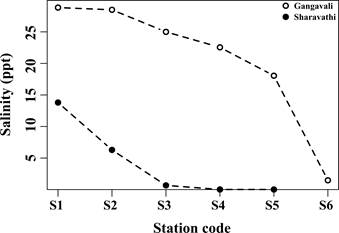 |
Impact of Hydroelectric Projects on Bivalve Clams in the Sharavathi Estuary of Indian West Coast
|
 |
M. Boominathanta,b, G. Ravikumarb, M. D. Subash Chandrana, T.V. Ramachandraa,*
aEnergy and Wetlands Research Group, Centre for Ecological Sciences, Indian Institute of Science, Bangalore - 560012, India,
bA.V.V.M. Sri Pushpam College, Poondi - 613503, Tamil Nadu, India
*Corresponding author: cestvr@ces.iisc.ac.in
Results
Salinity
In Gangavali estuary highest salinity recorded (in December 2011) was 28.85 ppt (station 1) and it decreased progressively in more upstream stations. Station 6 the most upstream one at 15 km from the river mouth had 1.48 ppt salinity. Sharavathi estuary, in comparison, had much lower salinities, ranging from 13.80 ppt in station 1 to 0.02 ppt in station 5. It is notable that at station 3 (6 km upstream) itself salinity was just 0.67 ppt (Fig. 2).

Fig. (2). Station-wise high tide salinity status in December 2011 in Gangavali and Sharavathi estuaries. Abbreviations of station code as given in the table 1.
Clam distribution
The Gangavali estuary, unaffected by hydroelectric projects, continues to have all the commercial clams reported in earlier studies. Polymesoda erosa was the only clam present in the Sharavathi estuary. The clam occurred in small quantities in stations 1 and 2 closer to the river mouth. The other clams which were recorded in earlier studies such as Meretrix meretrix and Meretrix casta could not be traced. Details of the clam distribution in relation to stations and salinity in the Gangavali and Sharavathi estuaries are given in Table 1.
Table 1. Station-wise distribution of clam bivalves in Gangavali and Sharavathi estuaries.
Station name |
Code |
Distance from River mouth (km) |
Salinity (ppt) |
Species |
Tg |
Pm |
Pe |
Mm |
Mc |
Vc |
Gangavali estuary |
Gangavali |
S1 |
1 |
28.85 |
+ |
+ |
+ |
+ |
+ |
|
Agragone |
S2 |
3 |
28.50 |
|
+ |
+ |
+ |
+ |
|
Joog |
S3 |
4.5 |
25.00 |
|
|
|
|
+ |
|
Sagadgeri |
S4 |
6 |
22.55 |
|
|
|
|
+ |
+ |
Ulware |
S5 |
8 |
18.05 |
|
|
|
|
|
+ |
Mangankan |
S6 |
15 |
1.48 |
|
|
|
|
|
+ |
Sharavathi estuary |
Honavar |
S1 |
2.5 |
13.80 |
|
|
+ |
|
|
|
Kasarkod |
S2 |
4.5 |
6.29 |
|
|
+ |
|
|
|
Hosapatna |
S3 |
6 |
0.67 |
|
|
|
|
|
|
Kelagin-Idgunji |
S4 |
8 |
0.02 |
|
|
|
|
|
|
Jalawalli |
S5 |
12 |
0.02 |
|
|
|
|
|
|
Note: Tg – Tegillarca granosa Linnaeus, Pm – Paphia malabarica Chemnitz, Pe - Polymesoda erosa Solander, Mm – Meretrix meretrix Linnaeus, Mc – Meretrix casta Chemnitz, Vc – Villorita cyprinoides Gray.
Citation : M. Boominathan, G. Ravikumar, M. D. Subash Chandran and T. V. Ramachandra, 2014. Impact of Hydroelectric Projects on Bivalve Clams in the Sharavathi Estuary of Indian West Coast, The Open Ecology Journal,2014, 7, 52-58
|
|